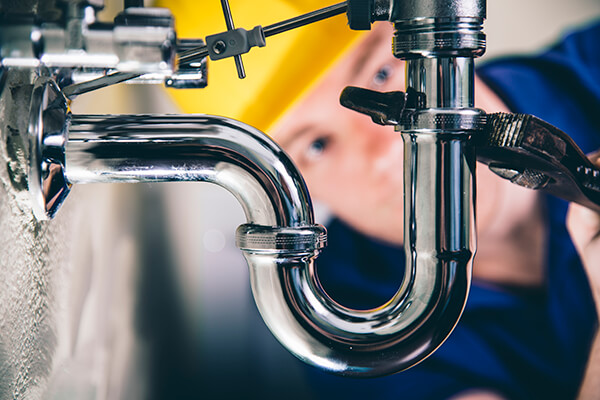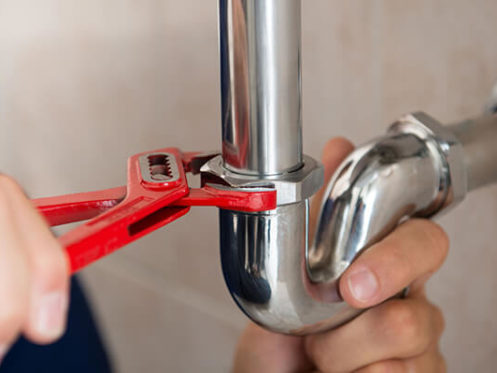Are you considering replacing your showerhead or another plumbing fixture? If so, you’ll need to know how to properly apply plumbing tape to ensure the new fixture doesn’t leak. The process for applying the tape is simple and only takes a few minutes. Nonetheless, it is essential that you take the time to do it properly, or else the connection will suffer from leaks. Here is everything you need to know about plumbing tape and how to correctly use it.
What Is Plumbing Tape?
Commonly referred to as thread sealing tape, plumbing tape is used to create a tight seal between male and female threaded pipe connections. As you tighten the connection, the tape gets pinched into the threads to help ensure a tighter seal. The tape also acts as a lubricant that makes threading the connection easier and allows the male end to extend further into the female connection.
Plumbing tape is made from polytetrafluoroethylene (PTFE), a synthetic chemical compound that is also used to create a non-stick coating on pans and other types of cookware. This chemical was originally developed by DuPont as Teflon, which is why many people also refer to plumbing tape as Teflon tape. When shopping for it in your local hardware store or plumbing supply shop, you may also see it simply labeled as PTFE tape.
Choosing the Right Plumbing Tape for the Job
There are four main types of plumbing tape, which are color-coded based on their application. Yellow plumbing tape is designed for use on gas and fuel lines, the green tape is used on oxygen lines, and white and pink plumbing tape is for water lines. All four types of tape can technically be used on water lines, but yellow and green tape tend to be more expensive. For this reason, you should always use either white or pink tape for water lines. Both tapes are designed specifically for potable water lines and connections, but there is a difference between the two.
The white tape has a much lower density, which tends to make it less expensive than the high-density pink tape. However, the white tape is also much thinner and tends to tear more easily, which can make it more difficult to work with. This thinness means you also typically need to use a bit more of the white plumber tape than you would pink tape to create a watertight seal. Due to these differences, most professional plumbers tend to prefer pink tape over white. Nonetheless, this is really a matter of preference, as both white and pink tape is fully acceptable for any of your plumbing uses.
Where You Should and Shouldn’t Use Plumbing Tape
Before looking into how the tape should be applied, it is first necessary to look at the situations where you should and shouldn’t use plumbing tape. This requires a basic understanding of the differences between pipe thread and hose thread. Plumbing tape is designed for use on metal and PVC or hard plastic pipe threads only, such as the type you’ll find on the end of a showerhead arm or sprinkler head. This type of connection creates a watertight seal using the threads themselves. Compare this to hose threads, which utilize a washer or rubber gasket to create the seal. In basic terms, plumbing tape should never be used on garden hoses, hose bibs, and any other hose connections with a gasket as it can make the connection more prone to leaking.
Although plumbing tape shouldn’t be used on hoses and other similar connections, you should use the tape on any of the following plumbing connections and fixtures.
- Sprinkler heads
- Irrigation valves
- Showerheads and shower arms
- Threaded bathtub spouts
- Threaded pipe-to-coupling or pipe-to-valve connections
Steps to Properly Apply Plumbing Tape
Before applying the plumbing tape, the first thing you need to do is thoroughly wash and clean both the male and female threads. Any dirt, rust, or grime on the threads will prevent you from getting a watertight seal. Therefore, it’s important to make sure the threads are clean and dry before applying the tape.
Once the threads are clean, the next step is to look at the direction that the threads run. Most pipes are threaded in a clockwise direction, but you may find some connections that are threaded in the opposite direction. It is important to pay close attention to this factor to ensure that you wrap the tape in the correct direction. The tape should always be wrapped around the pipe in the direction of the threads. This ensures that the friction of the threads tightens up the tape around the pipe. If the tape is wrapped the wrong way, the result is that the friction loosens up the tape causing it to unravel or clump together.

From there, slowly begin wrapping the tape down the pipe until you reach the end of the threads. Each new wrap should be placed so that half of it covers the wrap above it and half covers the bare pipe threads. You also need to make sure to keep tension on the tape as you wrap to ensure that it remains tight and snug around the pipe. In most cases, it will take somewhere around four to six wraps to completely cover the threads.
To ensure a proper seal, it is important that the tape is wrapped continuously from the open end of the pipe to the end of the threads. This means that if you accidentally break the tape while wrapping, it is best to remove the tape and start over again with a new piece.
Once you are finished, simply cut, or break the tape off the roll and then smooth the loose end into the threads. Now, all that is left to do is thread the male connector into the female until it is tight and then turn the water on to ensure that the connection doesn’t leak.
You should be able to tighten and loosen the connection multiple times without needing to replace the tape, such as when removing your showerhead to clean and descale it. However, you should always inspect the tape to make sure it still fully covers the threads. If the tape appears damaged or doesn’t fully cover every thread, it is best to replace it to ensure you won’t experience any leaks.
Professional Plumbing and HVAC Services
If you’re dealing with leaking pipes, clogs, or any other plumbing issue at your Newburgh home, our professional plumbers at Polar Plumbing, Heating & Air Conditioning are on hand to assist. We specialize in drain cleaning, rooter services, and water heater repair and installation. Our team also consists of highly trained heating and cooling technicians that can handle any of your cooling repair, heating installation, AC replacement, and furnace maintenance needs.
Contact us today to get the reliable, professional service your home deserves!

